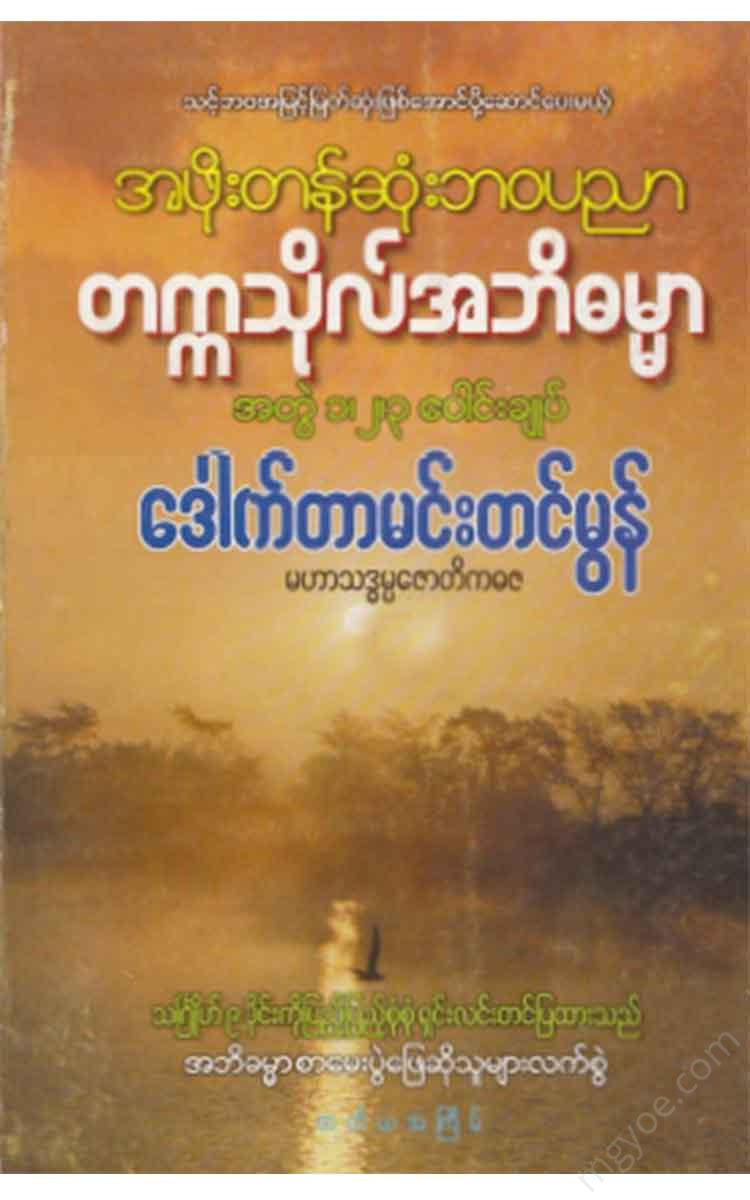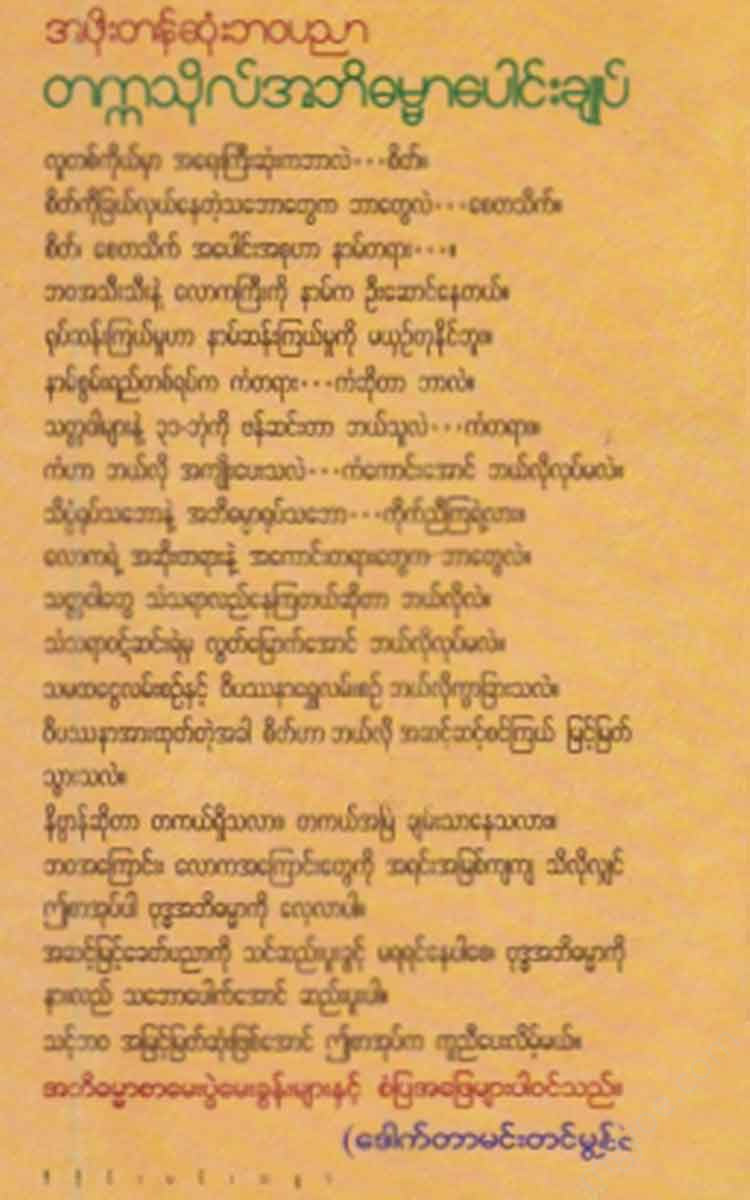Other Websites
Dr. Min Tin Mon - University Dictionary
Dr. Min Tin Mon - University Dictionary
Couldn't load pickup availability
:: Click on Buy it now to download the ebook . After placing your free order, the download link will be sent to the reader's email address used to log in to the mgyoe.com website.
:: The Ebook (Free) books on mgyoe.com are books that have been circulating on the internet for a long time.
:: It is just a compilation so that readers can easily find it when they want to read it.
:: If reprinted by bookstores, the download links for these e-books will be removed.
------------------------------------
Introduction
The sermon preached in heaven -
He understood all the Dhamma that was worth knowing with the help of the Buddha's wisdom. The Buddha, having recited the seventh Dhamma in the Tavatimsa, then, with his mother and the deva sons at his head, preached the Abhidhamma sermons to all the devas and brahmins continuously for three months during the fast.
Since one day in the Tavatimsa divine life is equal to one hundred human years, the three months of Lent are only a few minutes long in the Tavatimsa divine life.
When the time for daily alms-giving arrived, the Buddha, having appointed a Nimmita relic to continue preaching the Dhamma on his behalf, went to Uttarakuru, a northern island, to receive alms. Then he offered alms at the port of Anota Lake and spent the day in the Sandaku Forest. Then the Venerable Sariputta, the commander of the Dhamma army, came to the Buddha and made a great and small vow.
The Buddha said, "My dear son Sariputta, I have preached this much of the Dhamma," summarizing the Abhidhamma in a nutshell. Therefore, the Buddha preached the Abhidhamma doctrine in the human world at the same time as in the heavenly world.
The wise and learned Sariputta, who was a thousand times wise, understood the vastness of the Abhidhamma teachings given by the Buddha in a thousand ways. For example, when the Buddha stood on the shore of the Great Ocean and extended his hand to point out, Sariputta saw the entire vastness of the Great Ocean.
The Venerable Sariputta again preached the Abhidhamma sermon to his five hundred disciples in a medium manner, neither narrow nor broad. When the Blessed One had finished preaching the Abhidhamma sermon in Katsara, the Venerable Sariputta also finished preaching the Abhidhamma sermon in his own country.
The Abhima Pi that remains in the human world to this day is the Pitaka preached and taught by the Venerable Sariputta.
_ The distinctive features of Abhidhamma -
All the teachings preached by the Buddha are divided into three Pitakas: (1) Sutta Pitaka, (2) Vinaya Pitaka, and (3) Abhidhamma Pitaka.
The Sutta Pitaka is a collection of discourses that uses terms that are familiar to the general public, describing the desires, passions , and characteristics of sentient beings.
The Dhamma is ,
Important suttas such as the Dhammasakaya Sutta, the Anattalakhana Sutta, and the Patissasamuppapa Mahasatipadha are included in the Sutta Pitaka.
The Vinaya Pitaka is a collection of precepts and regulations that the Buddha prescribed for the monks who were the disciples of the Buddha. There are nine thousand, one hundred eighty-five million, thirty-six thousand of these precepts, and they are the rules that have led the Sangha to become the world's leading organization.
Among all those many precepts, the 227 precepts in the Bhikkhus' Discourse on the Path of the Buddha
The precepts are the basic and most important. These precepts are to be observed with special respect by monks as their code of conduct and ethics.
The Vinaya Pitaka is the lifeblood of the religion. Monks who live in accordance with the Vinaya are highly respected and revered.
If so, all people would be like fertile farmland where generations of meritorious deeds can be cultivated.
The Abhidhamma Pitaka is a collection of teachings that analyze and explain the three worlds - the material world, the material world, and the material world - and Nibbana, as four truly true and absolute truths. . . .
The Sutta Pitaka is a collection of discourses that gives maximum priority to the use of terms that are appropriate to the understanding of the Venerable.
The Vinaya Pitaka is a code of authority that the Buddha used to the greatest extent to command his disciples to follow and practice.
The Abhidhamma is the supreme teaching that the Buddha preached, completely and completely, in accordance with the process, without any omissions.
In preaching the Abhidhamma, the Buddha, with the power of omniscience, explored the entire natural world, explaining the natural processes of matter, form, matter, truth, senses, the path, the path of existence, and so on.
He delivered a comprehensive and critical discourse, using the Sutta, Abhidhamma, and Question and Answer methods, leaving no room for error.
In terms of the number of Dhamma bodies, there are 21,000 in the Sutta Pitaka, 21,000 in the Vinaya Pitaka, and 42,000 in the Abhidhamma Pitaka.
Therefore, the Abhima Pitaka surpasses the Sutta Pitaka in number, in the number of ways in which it is explained, and in its extraordinary mystery. It is because it is a more mysterious Dhamma than the Sutta Dhamma that it is called Abhima.
Abhi = extraordinary, extraordinary
Dhamma = Pali (Wa) Worthy of learning: The Dhamma well preached by the Buddha for the cessation of suffering for sentient beings.
The benefits of Abhima
When the Buddha contemplated the Dhamma from the Abhidhamma Pitaka, six rays of light shone forth.
During the time of Kassapa Buddha, five hundred bats, who were hiding in a cave, were able to concentrate on the sound of two monks reciting the Abhidhamma. With that good concentration, the five hundred bats, when they died, went to heaven.
They are two Buddhas who were disciples of Gautama Buddha from the time of Kassapa Buddha.
In between, they did not reach the heavens during the entire Buddha's lifetime, but continued to exist in the heavenly realms, one life after another.
During the time of Gotama Buddha, they became men. They attained the monastic life. They first studied the Abhidhamma Pitaka from the venerable Sariputta Thera and then became arahants who studied the Abhidhamma Pitaka.
When the Blessed One, Gotama, had finished preaching the Abhidhamma in the land of Tavatisana, eighty thousand gods and brahmins, having realized the Four Noble Truths, entered the Dhamma. His mother and her son also attained the state of Sotapatti.
The Abhidhamma breaks through the world of laws and explains the divine world through the fundamental truths of mind, consciousness, body, and Nibbana, thus clearly understanding the true nature of the universe. ' .
The two self-consciousnesses are merely the aggregate of form and form, and when one understands the natural processes of form and form , one can break down the delusions of "I am," "my own," and "I have a body," "I am a tortoise."
Therefore, if one studies the Abhidhamma teachings properly, one can attain the knowledge of reality that allows one to see the whole truth in all its aspects, with complete cause and effect. With that knowledge, one can overcome delusions, false views, doubts, and doubts.



